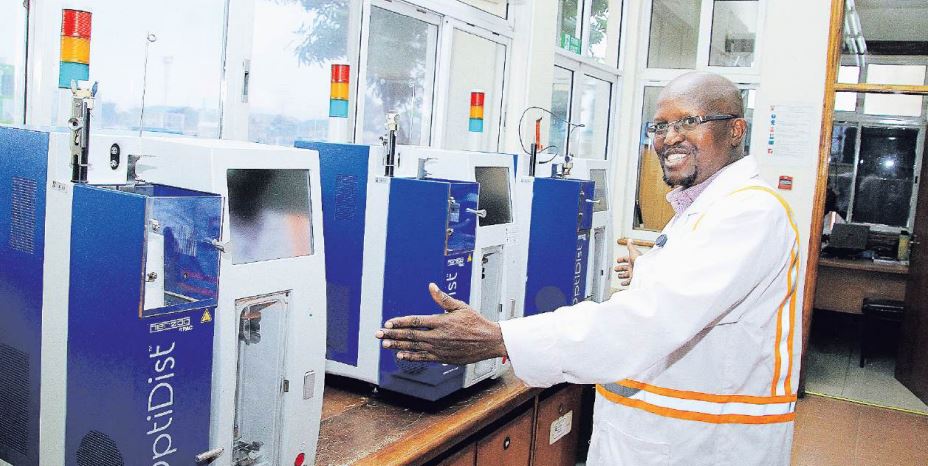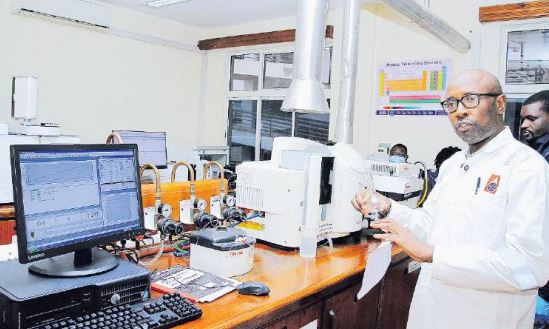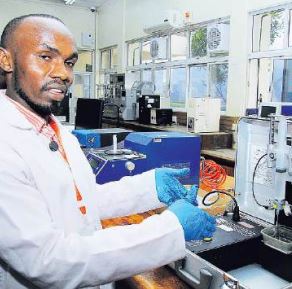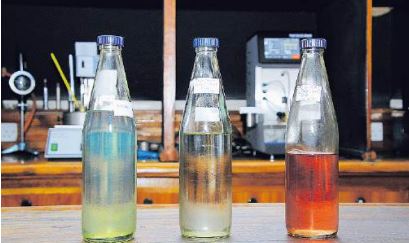
 Lab technician Arnold Dando explains how the manual distillation equipment works at the Kenya Pipeline laboratory /EZEKIEL AMING’A
Lab technician Arnold Dando explains how the manual distillation equipment works at the Kenya Pipeline laboratory /EZEKIEL AMING’AAt the heart of this system is the Kenya Pipeline Company (KPC), tasked with ensuring that every litre of petrol, diesel and jet fuel meets strict quality standards before it reaches consumers.
From high-tech laboratories to round-the-clock control room monitoring, KPC’s operations protect not just engines and equipment but also lives, public confidence and the national economy.
“Our role as a department is quality surveillance. We check the quality of product prior to arrival at the source and ensure it meets the different requirements,” Arnold Dando, a chemist at Nairobi Terminal, says.
“During transportation and handling of the same, the product is continuously checked to ensure that it meets the specifications that are laid out.”
At Nairobi Terminal’s quality control and assurance section, petroleum products are subjected to rigorous testing. Dando explains that KPC operates multiple laboratories across its pipeline network in Mombasa, Nairobi (two facilities: petroleum and environmental), and at PS25, PS27 and PS28, all responsible for ensuring the quality of product delivered to customers.
“All our laboratories are ISO 17025 accredited,” he says.
“That means the test results we produce in our laboratories are valid, and we can provide objective evidence to prove that the results are indeed valid.” The labs operate 24 hours a day in shifts to match the continuous operation of KPC’s pipeline system.
 Edmond Momanyi takes the media through the Kenya Pipeline environmental laboratory /EZEKIEL AMING’A
Edmond Momanyi takes the media through the Kenya Pipeline environmental laboratory /EZEKIEL AMING’A
The range of petroleum grades handled includes motor spirit premium (petrol), automotive gas oil (diesel) and jet fuel (Jet A), all transported through a single pipeline. This setup, Dando says, presents a technical challenge.
“The product is transported head to tail, with interfaces forming between petroleum grades. That is a challenge that multi-product pipelines face when they have to transport more than one grade in a single pipeline,” he says.
These interfaces, the portions where two products meet, must be carefully managed to avoid contamination.
“They are sloped and separated from the pure product,” he says, explaining that similar-grade interfaces are cut directly into pure product tanks.
One of the key tools in quality assurance is the manual distillation equipment, which provides the volatility characteristics of petroleum products.
 Ian Daniel
shows how
the thermal
oxidation
tester for jet
fuel works
at the Kenya
Pipeline
laboratory
/EZEKIEL AMING’A
Ian Daniel
shows how
the thermal
oxidation
tester for jet
fuel works
at the Kenya
Pipeline
laboratory
/EZEKIEL AMING’A
“When the temperature of your engine is hot and the only thing you have are only the volatile components, you end up with a vapour lock.“ That again gives you problems when you are driving your car. So those volatility characteristics are key.”
From manual methods, KPC also employs automated systems that free up technicians to handle other tasks while the analysis runs. This ensures efficiency without compromising the integrity of the testing process.
For jet fuel, another crucial piece of equipment is the Microseparometer (MSEP), which tests the product’s ability to release water during filtration. Dando warns of the risks when fuel fails this test.
“If your fuel has traces of water, the water will crystallise at zero degrees centigrade and prevent the flow of the fuel through filters in an aircraft. When you have failure of the engine at high altitude, that is a crash.”
LAB, CONTROL ROOM
Alongside the petroleum lab is KPC’s environmental laboratory, dedicated to testing water, soil and other samples to ensure compliance with environmental regulations. The facility’s ISO 17025 accreditation ensures its results are internationally recognised.
 Samples of fuel that Kenya Pipeline imports: kerosene, diesel and petrol
/EZEKIEL AMING’A
Samples of fuel that Kenya Pipeline imports: kerosene, diesel and petrol
/EZEKIEL AMING’A
This work safeguards both environmental health and public safety. The environmental team also conducts monitoring around pipeline routes and depots to detect any leakage or contamination early. Their results feed into mitigation strategies that help KPC operate sustainably while meeting its mandate.
If the laboratories are KPC’s guardians of quality, the Control Room and field operations are its nerve centre, where every litre of fuel is accounted for and every movement is closely coordinated. At PS10, operations chief technician Rachel Simiyu manages Line 5, a 450km multi-product pipeline from Mombasa to Nairobi.
“It carries what you call MSP, which is motor spirit premium (petrol).It carries AGO, which you call diesel, and it carries DPK, dual purpose kerosene,” she says.
“This DPK is either used domestically or as JT1 to fuel the aircrafts. The JT1, we get it from the hard cut of the DPK batch.”
 Rachel Simiyu, the controller of Line 5, which controls fuels from Mombasa to Nairobi /EZEKIEL AMING’A
Rachel Simiyu, the controller of Line 5, which controls fuels from Mombasa to Nairobi /EZEKIEL AMING’A
Pump stations from Changamwe (PS1) to Nairobi maintain this flow, calculated for volume at every kilometre. Midway through her explanation, an operational alert comes in. Simiyu takes calls from colleagues upstream.
“PS14 says it was ESB high, meaning maybe there was a power dip in your station. Maybe it is a power dip. Please check so that you normalise so that we can start,” she says.
Her composure and coordination underscore the constant vigilance needed to keep the country’s fuel supply uninterrupted. In the same operations hub, pump over technician James Njoroge explains how products are moved from the depot to oil marketers.
“We pump product from our depot within the tank farm to oil marketers,” he says.
“We have seven oil marketing companies that we pump products to. We have MSP, which is petrol, AGO, which is diesel, and we pump kerosene.”
Orders are placed through a portal, but approvals are rigorous.
“It first goes to KRA because our depot is a custom-bonded warehouse. You cannot remove any product without their approval,” Njoroge says.
“The order has to be approved by KRA, then it comes to Kenya Pipeline and is approved by the terminal manager before we execute.”
Schedules are based on market share, with larger marketers allocated more hours. Before any pumping, samples are taken to the lab for analysis.
“Without a release certificate, you cannot pump a product from our depot because you might be pumping a product that is not of good quality,” Njoroge says.
Technology underpins the process.
“We have an automatic tank gauging system to know the level, temperature, and density of the product. The pumping system is Scada. We can open a valve or start a pump from here,” he says.
“The metering system, called Synergy, measures the volumes we pump to the oil marketers. If I’m pumping 299 and there’s a power failure, the system stops at that point, and when power resumes, it continues from where it left.”
Safety is paramount.
“We have high-level alarms that sense when the product has reached a certain level with a risk of spilling. It automatically stops the pumps and closes the valves before the product spills,” Njoroge says.
From Simiyu’s oversight of a 450km pipeline to Njoroge’s precision in depot pumping, KPC’s operations run on coordination, technology and disciplined adherence to safety protocols, ensuring that every order is fulfilled and every litre delivered without compromise.
COMMUNITY IMPACT
KPC’s work has direct and indirect impacts on communities. By ensuring a steady and safe fuel supply, it supports industries, transport systems and economic activity nationwide.
The company also provides jobs in operations, engineering, laboratory science and environmental management, alongside indirect employment through contractors and service providers. Training and capacity building are part of this community investment.
Staff are trained in both technical and safety procedures, ensuring that skills transfer and professional development remain ongoing priorities. In the reporting period, KPC recorded operational efficiencies and infrastructure improvements.
Investments in modern laboratory equipment, control systems and pipeline upgrades have enhanced service reliability and reduced operational risks.
Projects aimed at increasing storage capacity and improving product handling have also been implemented, aligning with the company’s longterm strategic goals.
KPC plays a central role in the country’s energy security, ensuring that fuel is available when and where it is needed. Its integrated systems, from port reception to inland storage and distribution, minimise the risk of shortages.
The continuous monitoring of pipeline operations and quality assurance of products underpins this stability, making KPC a critical player in the national economy’s functioning.
KPC operates under strict regulatory frameworks, adhering to both Kenyan and international standards. ISO accreditation, Nema compliance and adherence to Kenya Bureau of Standards specifications are part of its governance measures. Challenges include managing the complexities of transporting multiple fuel types through a single pipeline, handling product interfaces and maintaining infrastructure against wear and environmental factors.
From its laboratories to its control rooms, KPC’s operations are designed to ensure that every drop of fuel reaching the Kenyan market is safe, high-quality and delivered efficiently.
The meticulous testing processes, constant monitoring and adherence to standards form an unseen but vital backbone of not only the country’s energy supply chain but that of the country.
As Dando summarises, “We have laboratories scattered across our pipeline network.All of them are responsible for ensuring that the quality of the product that reaches our customers is as expected.”
It is a reminder that beyond the pump, an intricate network of people, technology and processes works around the clock to keep the country moving.











